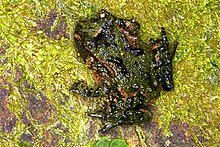Hochstetter's frog: Difference between revisions
Tnarg 12345 (talk | contribs) added map |
GrahamBould (talk | contribs) Added discovery para |
||
| Line 27: | Line 27: | ||
It has partially webbed feet, and [[atavistic]] tail-wagging muscles although it does not have a tail. It does not go through a [[tadpole]] stage, but instead develops totally within a gelatinous capsule derived from an egg, and therefore does not need standing or running water. However, it is very dependent on a damp environment, and quickly dries out and dies if placed in a dry place. |
It has partially webbed feet, and [[atavistic]] tail-wagging muscles although it does not have a tail. It does not go through a [[tadpole]] stage, but instead develops totally within a gelatinous capsule derived from an egg, and therefore does not need standing or running water. However, it is very dependent on a damp environment, and quickly dries out and dies if placed in a dry place. |
||
Hochstetters frogs are hard to locate as they are well [[camouflage]]d, are [[nocturnal]], and do not croak. |
Hochstetters frogs are generally dark brown and have more [[wart]]s than the other endemic New Zealand frogs. They are hard to locate as they are well [[camouflage]]d, are [[nocturnal]], and do not croak. However, there is hope that they are not quite as rare as feared - in December 2004 eleven Hochstetters frogs were found in a fragile, rocky area on [[Maungatautari Restoration Project|Maungatautari Mountain]]. Subsequent survey work has indicated that there is a small sparse population (including juveniles) in at least 2 catchments totalling 120 ha on the mountain. |
||
==References== |
==References== |
||
Revision as of 11:53, 14 June 2006
| Hochstetters frog | |
|---|---|

| |
| Hochstetters frog Leiopelma hochstetteri | |
| Scientific classification | |
| Kingdom: | |
| Phylum: | |
| Subphylum: | |
| Class: | |
| Superorder: | |
| Order: | |
| Family: | |
| Genus: | |
| Species: | L. hochstetteri
|
| Binomial name | |
| Leiopelma hochstetteri Fitzinger, 1861
| |

| |
| Range of Hochstetters Frog. | |
Hochstetters frog (Leiopelma hochstetteri) is a New Zealand primitive frog, one of only four belonging to the ancient family Leiopelmatidae and found only in the northern half of the North Island of New Zealand, including Great Barrier Island. Although it is the largest of the four species it grows to only about 48 mm long, and is found in isolated pockets, in damp areas along the edges of streams.
It has partially webbed feet, and atavistic tail-wagging muscles although it does not have a tail. It does not go through a tadpole stage, but instead develops totally within a gelatinous capsule derived from an egg, and therefore does not need standing or running water. However, it is very dependent on a damp environment, and quickly dries out and dies if placed in a dry place.
Hochstetters frogs are generally dark brown and have more warts than the other endemic New Zealand frogs. They are hard to locate as they are well camouflaged, are nocturnal, and do not croak. However, there is hope that they are not quite as rare as feared - in December 2004 eleven Hochstetters frogs were found in a fragile, rocky area on Maungatautari Mountain. Subsequent survey work has indicated that there is a small sparse population (including juveniles) in at least 2 catchments totalling 120 ha on the mountain.
References
- Template:IUCN2006 Database entry includes a range map and justification for why this species is vulnerable
- Chris Mattison, Frogs & Toads of the World, (Blandford, London, UK 1992) ISBN 0-7137-2355-6
